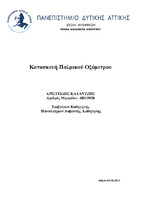| dc.contributor.advisor | Asvestas, Pantelis | |
| dc.contributor.author | Καλαντζής, Αριστείδης | |
| dc.date.accessioned | 2023-10-10T08:02:52Z | |
| dc.date.available | 2023-10-10T08:02:52Z | |
| dc.date.issued | 2023-10-05 | |
| dc.identifier.uri | https://polynoe.lib.uniwa.gr/xmlui/handle/11400/5244 | |
| dc.identifier.uri | http://dx.doi.org/10.26265/polynoe-5082 | |
| dc.description.abstract | Σκοπός της συγκεκριμένης εργασίας είναι η κατασκευή μιας φορητής διάταξης, που καταγράφει ορισμένα βασικά βιοσήματα, όπως ο καρδιακός ρυθμός (ΒΡΜ) και το ποσοστό οξυγόνου στο αίμα (SpO2) του ανθρωπίνου σώματος. Η προβολή των δεδομένων θα γίνεται σε πραγματικό χρόνο πάνω στη διάταξη, ώστε ο εξεταζόμενος να μπορεί να έχει μια εικόνα της κατάστασης του. Θα είναι, επίσης, εφικτή απομακρυσμένης μετάδοσης σε πραγματικό χρόνο των δεδομένων με τη χρήση ειδικής εφαρμογής (Blynk) στο κινητό τηλέφωνο ή τον υπολογιστή με σκοπό την εξ αποστάσεως παρακολούθηση της κατάστασης του εξεταζόμενου από κάποιο ιατρικό ή συγγενικό του πρόσωπο.
Τα κύρια εξαρτήματα και διατάξεις, που θα χρησιμοποιηθούν για την εκπόνηση του κατασκευαστικού μέρους της εργασίας, είναι ο μικροελεγκτής ESP8266, ο οποίος χρησιμοποιείται ευρέως στην κατασκευή του NodeMcu και άλλων παρεμφερών διατάξεων και είναι υπεύθυνος τόσο για την επεξεργασία όσο και για την ασύρματη μετάδοση των δεδομένων, ο αισθητήρας βιοσημάτων Max30102 για τη μέτρηση των βιολογικών παραμέτρων, η οθόνη Nokia 5110 Graphic LCD για την προβολή των δεδομένων τοπικά από το χρήστη και τέλος μία μπαταριά LiPo με σκοπό την πλήρη φορητότητα και αυτονομία της συσκευής, καθώς και ένα φορτιστής μπαταρίας λιθίου βασισμένο στα ολοκληρωμένα TP4056 και DW01A για την προστασία και σωστή φόρτιση της διάταξης.
Η επιλογή όλων των κύριων και δευτερευόντων περιφερικών εξαρτημάτων έγινε με γνώμονα τον λόγο κόστους – απόδοσης, καθώς και τον λόγο απόδοσης - αυτονομίας.
Τέλος, έπειτα από σύγκριση της διάταξης, με άλλες εμπορικά διαθέσιμες συσκευές παλμικής οξυμετρίας, αναφέρονται κάποια συμπεράσματα για το κατά πόσο μια τέτοια διάταξη, με αυτές τις προδιαγραφές, θα μπορούσε να αντικαταστήσει επιτυχώς ένα εμπορικού τύπου παλμικό οξύμετρο και τυχόν πλεονεκτήματα σε σχέση με αυτό. | el |
| dc.format.extent | 65 | el |
| dc.language.iso | el | el |
| dc.publisher | Πανεπιστήμιο Δυτικής Αττικής | el |
| dc.rights | Αναφορά Δημιουργού - Μη Εμπορική Χρήση - Παρόμοια Διανομή 4.0 Διεθνές | * |
| dc.rights.uri | https://creativecommons.org/licenses/by-nc-sa/4.0/deed.el | * |
| dc.subject | Παλμικό οξύμετρο | el |
| dc.subject | Arduino | el |
| dc.subject | Esp8266 | el |
| dc.subject | NodeMcu | el |
| dc.subject | Μικροελεγκτής | el |
| dc.subject | Καρδιακοί παλμοί | el |
| dc.subject | Κορεσμός οξυγόνου | el |
| dc.subject | PPG | el |
| dc.subject | SpO2 | el |
| dc.subject | Max30102 | el |
| dc.subject | Nokia 5110 Graphic LCD | el |
| dc.subject | Blynk | el |
| dc.subject | Final project | el |
| dc.subject | Pulse oximeter | el |
| dc.subject | Microcontrollers | el |
| dc.subject | Heart rate | el |
| dc.subject | Oxygen saturation | el |
| dc.title | Κατασκευή παλμικού οξύμετρου | el |
| dc.title.alternative | Construction of a pulse oximeter device | el |
| dc.type | Διπλωματική εργασία | el |
| dc.contributor.committee | Kostopoulos, Spiros | |
| dc.contributor.committee | Glotsos, Dimitris | |
| dc.contributor.faculty | Σχολή Μηχανικών | el |
| dc.contributor.department | Τμήμα Μηχανικών Βιοϊατρικής | el |
| dc.description.abstracttranslated | The purpose of this project is to construct a portable device that records certain basic biosignals, such as heart rate (HR) and blood oxygen saturation (SpO2) of the human body. The data will be displayed in real-time on the device so that the examinee can have a picture of their condition. Real-time remote transmission of the data will also be possible using a special application (Blynk) on a mobile phone or computer for remote monitoring of the examinee's condition by his doctor or a relative.
The main components and devices that will be used to develop the construction part of the project are the ESP8266 microcontroller, which is widely used in the construction of NodeMcu and other similar devices, and is responsible for both processing and wireless transmission of data, the Max30102 biosensor for measuring biological parameters, the Nokia 5110 Graphic LCD screen for local data display by the user, and finally a LiPo battery for complete portability and autonomy of the device, as well as a lithium battery charger module based on the TP4056 and DW01A integrated circuits for the protection and proper charging of the device.
The selection of all the main and secondary peripheral components will be based on the cost-performance ratio as well as the performance-autonomy ratio. Finally, after comparing the device with other commercially available pulse oximetry devices, conclusions are reported on whether such a device, with these specifications, could successfully replace a commercial-type pulse oximeter and any advantages it may have to it. | el |


